Embarking on a Spiritual Odyssey
I travelled Bongaigaon, a busy Assamese town, on a clear November morning in order to travel to Dhubri, a district rich in spiritual and historical value. My objective was the famous Panchapeer Dargaha perfectly captures the complex fabric intersection of various faiths.
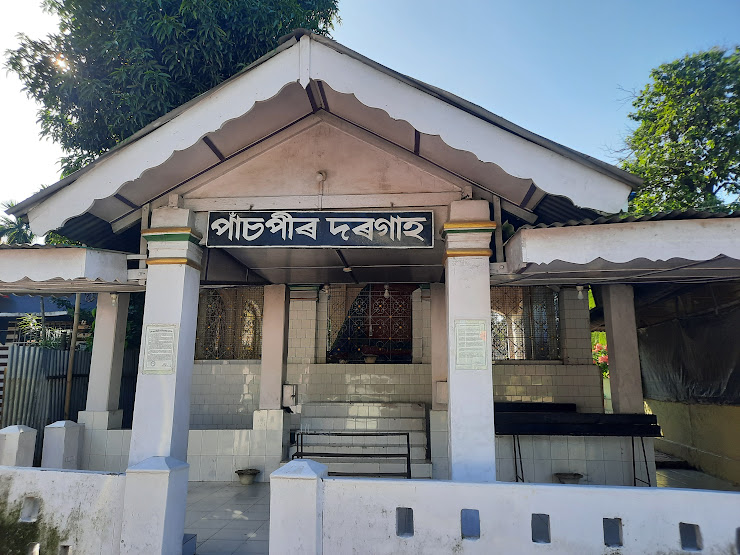
The Road Less Traveled
The road from Bongaigaon to Dhubri is around 85 km long and winds through charming villages, lush scenery, and the tranquil banks of the Brahmaputra River. Despite its modest size, the route is full with images of rural life, including farmers working their fields, excited youngsters and the occasional tea stall providing a nice break. I could see Dhubri’s distinct appeal as I got closer. A cultural melting pot, Dhubri lies tucked away along the Brahmaputra. The district’s spirit of unity in variety is reflected in the peaceful coexistence of temples, mosques, and gurudwaras.
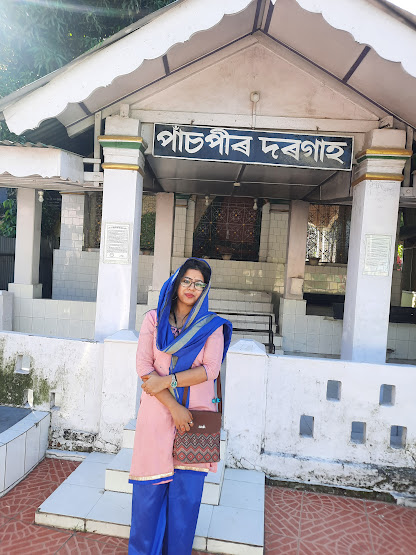
The drive itself was a peaceful one. The path went through expanses of forested land, sleepy hamlets, twisting rivers, and verdant farms. Magnificent and ever-present, the Brahmaputra River ran alongside in some places, its leisurely flow resonating with the cadence of rural life.
As I neared Dhubri, the scenery gradually transitioned into a more urban setup, yet retained its quaint charm. Dhubri is not your typical town. It is a confluence of religions, languages, and traditions, where temples stand peacefully beside mosques, and gurudwaras echo with the sounds of Gurbani.
Arriving at Panchapeer Dargaha
The Panchapeer Dargaha, situated in Boro Bazar (Ward No. 1), is believed to be over 350 years old. According to local lore and historical texts, the shrine commemorates five revered Sufi saints—Shah Akbar, Shah Bagmar, Shah Sufi, Shah Sarban, and Shah Kamal—who accompanied Raja Ram Singh during his military campaign in the 17th century under the Mughal emperor Aurangzeb.
But this place is far more than just a memorial. It is a living symbol of syncretism, a space where the divine transcends religious boundaries. Hindus, Muslims, Sikhs, and even Christians visit this shrine, each finding solace in the sacred energy that envelopes the site.
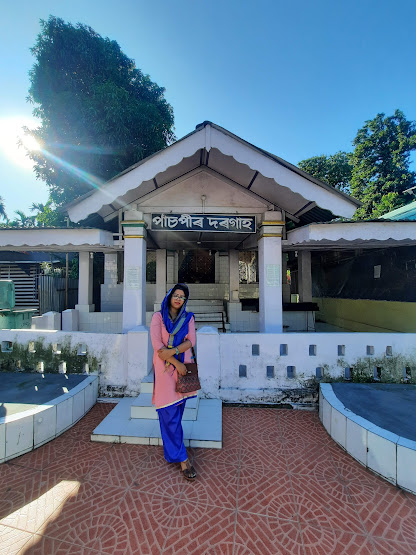
The dargaha structure is modest but steeped in spiritual gravitas. The inner sanctum, where the tombs are located, is draped with green and red chadars (sacred cloth). Devotees light incense sticks and offer flowers while silently whispering prayers. The fragrance of sandalwood mingles with the breeze, creating a calm, ethereal atmosphere.
Panchapeer Dargaha: A Testament to Syncretism
The dargaha, established in 1662, is more than just a mausoleum; it is a symbol of the region’s syncretic culture. Devotees from various faiths—Muslims, Hindus, Sikhs, and others—flock to the shrine, seeking blessings and paying homage to the saints. The annual Urs festival, commemorating the saints’ death anniversaries, transforms the dargaha into a hub of spiritual fervor, with prayers, qawwalis, and communal feasts . you can visit https://dhubri.assam.gov.in/tourist-place-detail/274
Festival and Community Spirit
It’s not just about ritual—it’s about community, compassion, and remembrance. It reminded me how spiritual places like Panchapeer are not just geographical locations, but vibrant centers of collective memory and hope.
Architectural Elegance and Spiritual Aura
The dargah’s architecture is a blend of simplicity and grace. The central tombs, adorned with green chadars and incense sticks, exude an aura of serenity. The surrounding courtyard, shaded by ancient trees, offers a tranquil space for reflection and prayer. The gentle hum of devotees reciting verses adds to the sanctity of the place.
What struck me most was the palpable sense of unity. People from diverse backgrounds sat side by side, sharing stories, offering prayers, and partaking in the communal langar. It was a poignant reminder of the power of faith to bridge divides and foster understanding.

Intertwining Histories: The Dargaha and the Gurudwara
A short distance from the dargaha lies the Gurudwara Sri Guru Tegh Bahadur Sahibji, another testament to Dhubri’s rich spiritual landscape. Historical accounts suggest that Guru Tegh Bahadur, the ninth Sikh Guru, visited this region during the same period as the Sufi saints. The proximity of these two sacred sites underscores the intertwined histories and mutual respect among different religious communities in Assam .
Reflections and Reverence
As I sat in the dargah’s courtyard, absorbing the harmonious ambiance, I couldn’t help but reflect on the lessons this sacred space imparted. In an era often marred by divisions, the Panchapeer Dargaha stands as a testament to unity, compassion, and shared humanity.
The journey from Bongaigaon to Dhubri was more than a physical traversal; it was a spiritual voyage that deepened my appreciation for Assam’s rich cultural mosaic. The Panchapeer Dargaha, with its profound history and enduring message of harmony, remains etched in my heart as a beacon of hope and unity
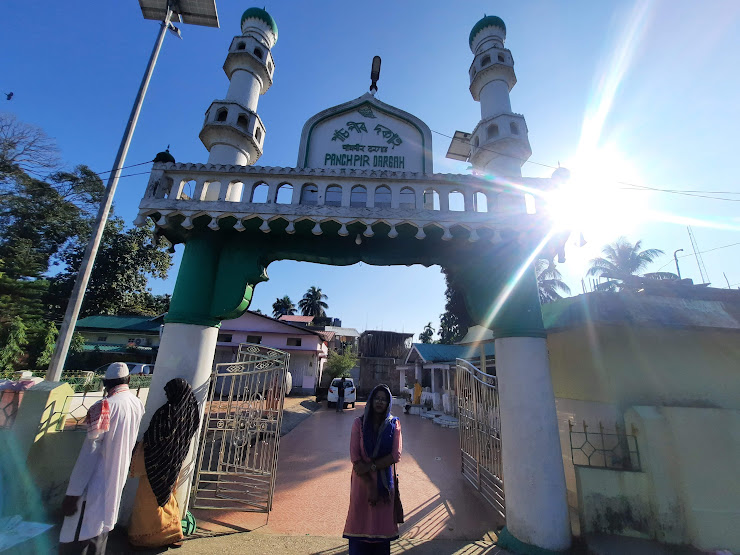
Echoes of History and Harmony
Amazingly, one of the oldest Sikh shrines in the area, the Gurudwara Sri Guru Tegh Bahadur Sahib, is also located in Dhubri. The Panchapeer Dargaha is not far from the gurudwara, which was constructed to commemorate the ninth Sikh Guru’s visit to Assam. According to historical accounts, Guru Tegh Bahadur and the Sufi saints were both in Assam at a tumultuous period when religious exchange, local opposition, and military conquests were determining the future of the region.
The way the soil absorbed everything—not just the conflict, but also the coexistence—was what most surprised me. These shrines are now symbols of harmony, tolerance, and unwavering faith rather than remnants of separation.
Practical Tips for Visitors
If you’re planning to visit the Panchapeer Dargaha:
- Best Time to Visit: October to April. The weather is cooler and festivals like Urs often fall in this window.
- Respect Local Customs: Dress modestly. Shoes must be removed before entering the dargah.
- Local Cuisine: Don’t miss the roadside jalebis and samosas in Boro Bazar. There are also small eateries serving local Assamese and Bengali food.
- Travel Options: You can reach Dhubri via private car, bus, or train from Bongaigaon. It’s a smooth journey that takes around 2–2.5 hours.
- Stay Options: Dhubri has modest hotels and guesthouses. Book ahead during festive seasons.
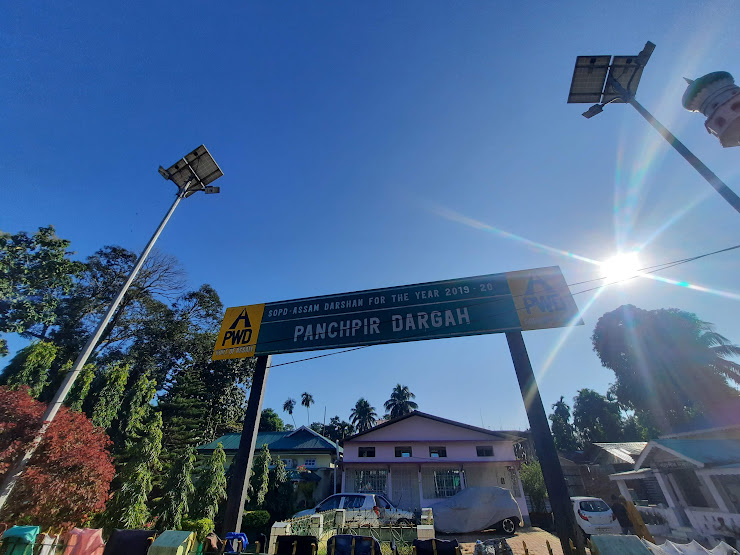
A Shrine for All
My visit to the Panchapeer Dargaha served as a pleasant reminder that the soul has no religion and the heart recognises no division in a world when political and ideological boundaries appear to be becoming increasingly inflexible.
When the sun set that evening, the rice fields took on a golden tint as I drove back to Bongaigaon. More than just memories, I brought with me a sense of spiritual fulfilment, a renewed faith in our common humanity, and a silent resolve to do my part to preserve the spirit of unity.
Thank you for reading. If you’ve visited a sacred site that moved you deeply, I’d love to hear your story in the comments below.
Note: For those planning a visit, the best time is between October and April, when the weather is pleasant, and festivals like Urs offer a deeper insight into the dargah’s spiritual significance. Ensure to dress modestly and respect the sanctity of the place.
